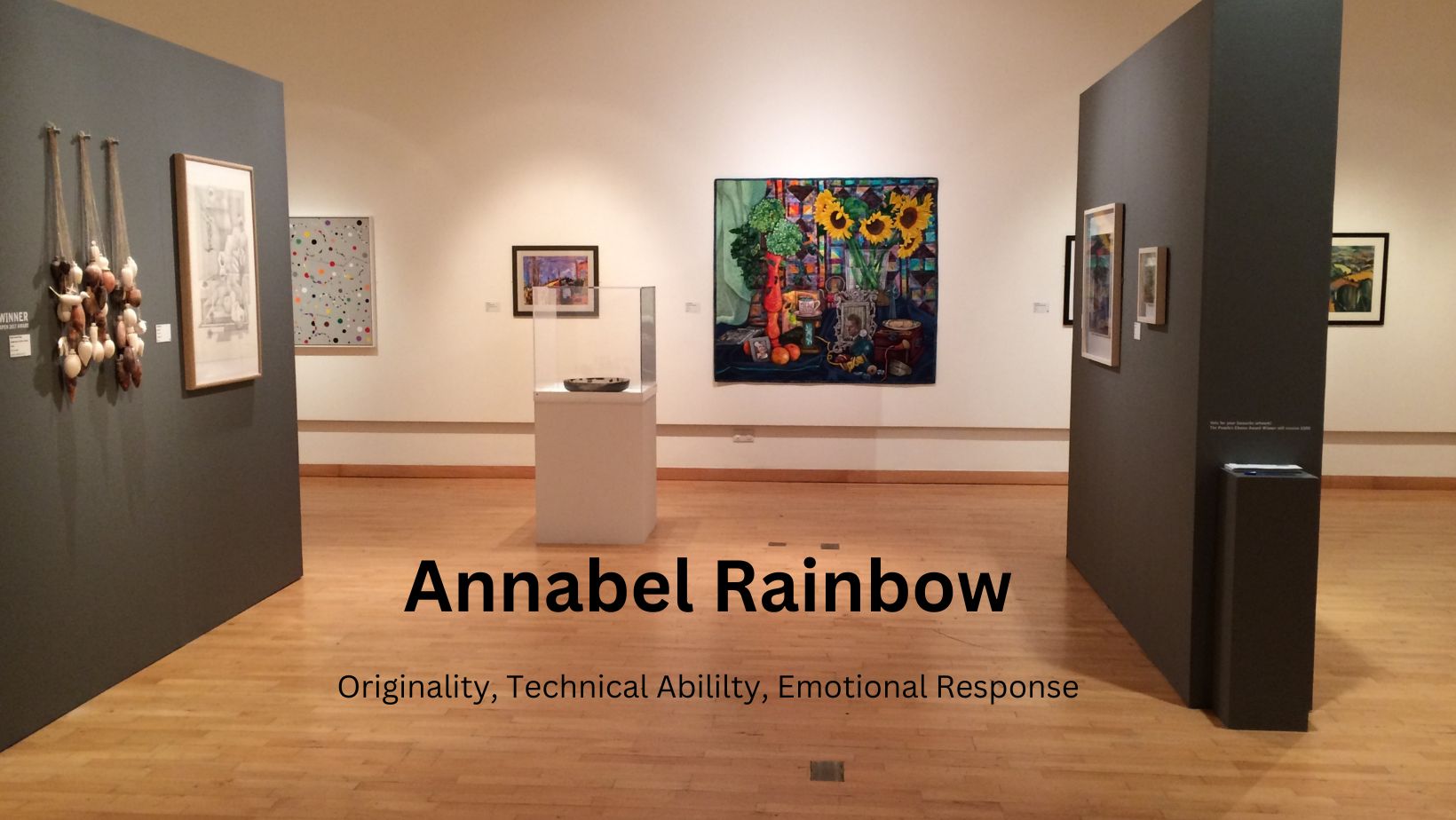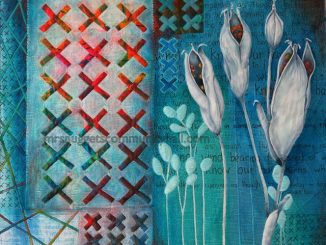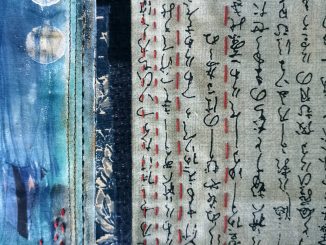
Quilt – Stepping Off The Edge
103cms (40.5″) long x 69cms (27″) wide
From sampler to momento mori. By Annabel Rainbow. The first posting about a collection of quilts made for an upcoming exhibition.
I thought I’d share the story of this quilt made for exhibition at Leamington Spa Art Gallery next year. It was inspired by an embroidered Victorian sampler in the Museum’s collection (picture below). It was stitched by a young girl and has a prayer on the bottom of it:
“God of my childhood and my youth. The guide of all my days. I have declar’d thy heavenly truth. And told thy wonderous ways.”
Memento mori is simply a Latin phrase meaning “remember you must die” It’s a concept that has it’s origins in early medieval history and the idea was to remind us all not to dwell on the earthly but to think beyond to an afterlife. Flemish and Dutch painters famously explored this concept too and were very popular, producing some amazing still life paintings with skulls or other symbols to show time passing and the temporary nature of life, such as hour glasses (or in my 2023 case, chicken egg timers to bring it up bang to date), clocks, extinguished or guttering candles, fruit, and dying and decaying flowers. The sampler with it’s prayer made me think of this and so I’ve used these ideas to make my own version in quilt/wallhanging form.
The piece is called Stepping Off The Edge because of the bronze stepping off the shelf on the left hand side and symbolises life after death, and going into the unknown. I took a photo of the little bronze-like sculpture in the TKMaxx homewares department sale and used it because it spoke to me! Giacometti and all that.
I’ve also linked to other artefacts from the gallery’s collection, using images of a child’s balancing toy, and a large pot which I’ve put honesty seedheads in. Honesty seeds are often associated with honesty, money and sincerety, but they are also thought to be protective and to keep away monsters and frightening things. The raven represents ancient wisdom and is a spectral messenger “bearing the weight of untold visions and prophetic whispers”. It’s dripping paint onto a small book which has the words “The moving finger writes…” stitched on. (The full quote is: “The Moving Finger writes; and, having writ moves on: nor all thy Piety nor Wit Shall lure it back to cancel half a Line, Nor all thy Tears wash out a Word of it.” Omar Khayyám )
The quote stitched over the whole quilt is “I wasted time and now time doth waste me” and is from Richard II, Shakespeare. The clock hands are made of the words *the life of time is motion* and were taken from a clock at Snowshill Manor in Glos. (National Trust) The scarf is an infinity scarf – one without beginning or end, and even I don’t know what the key is to and what it unlocks! The little sampler which is nailed to the shelf is made from fabric printed onto specially prepared material which you can buy to use with a home printer. To get it to look like that I simply printed the photo of the museum’s sampler onto paper. I then folded the paper to look like it was hanging from a shelf, and reproduced that second photo onto cloth.
Why a quilt? A quilt is just 3 layers stitched together. The first layer is the imagery/painting/collage which is then layered with wadding – in this case felt – and backed with another piece of plain cotton. The stitching is done through all three layers which gives a lovely feel to the piece and allows it to be hung on a wall and look straight and professional without any sagging or movement.


The sampler
“The English word ‘sampler’ derives from the Latin ‘exemplum’, or the old French term ‘essamplaire’, meaning ‘an example’. Before the introduction of printed designs, embroiderers and lacemakers needed a way to record and reference different designs, stitches and effects. The answer was to create a sampler – a personal reference work featuring patterns and elements that the owner may have learned or copied from others, to recreate again in new pieces.
Such stitch and pattern collections may have been assembled in a number of cultures where decorative needlework was widely practised. Early examples rarely survive, but the quality of the oldest surviving samplers suggests they were made by experienced hands, as well as children, (in many cultures learning needlework was an important part of a young girl’s education). The earliest in our collection were found in Egyptian burial grounds, and probably date from the 14th or 15th centuries.
LSAGM have a number of samplers in their collection, but I liked this blue and white one, with it’s prayer at the bottom.
The V&A continue about 19th century samplers…
“Moral or religious texts, though usually less personal (than Parker’s), continued to be a frequent choice in the first half of the 19th century. First popular in England in the mid-17th century, these improving or pious statements are central to the often fairly unsophisticated pieces we now recognise as a ‘classic’ Victorian sampler. This type of piece was also important in the embroidery traditions of European settlers in America, whose strongly felt sense of religious purpose helped to sustain them in an unfamiliar and often unforgiving landscape. A more accomplished piece stitched by ‘E Pratt’ in the ‘New Orphan House Ashley Down Bristol’ in 1886 helps demonstrate that in the 18th and 19th centuries samplers were increasingly being used as an educational tool for girls from all social backgrounds.”
The sampler in the LSAGM collection

And a close up of my version

The balancing act toy

The pot that holds the honesty seed heads.





Be the first to comment